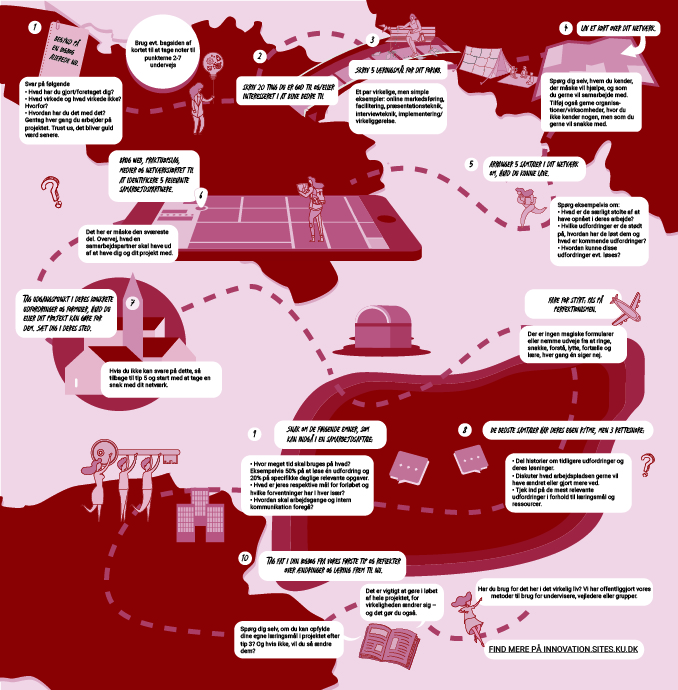Instructions
The method is divided into two parts, where the first half focuses on presentations of project ideas and the participants themselves as well as interactions around projects, while in the second half external guests are invited to share their experiences and goals.
FIRST PART
10 minutes: Introduction to the workshop programme – point out specifically that this is an opportunity to expand people’s network and get feedback from unexpected perspectives.
30 minutes: All participants introduce themselves and present their initial ideas to the whole group. If you have the expertise or a relevant partner does, you can also talk about presentation techniques and give feedback to the participants on their presentations.
30 minutes: In pairs, students practise asking questions to each other about their projects and themselves for five minutes before switching. The aim is to focus on empathy for the conversation partner and the concrete definition of their challenges as they see them. This can be supplemented with material about the phases Empathize and Define in Design Thinking – just replace the user with appropriate designations.
15 minutes: Together the whole group summarises what has been gained from presentations and rounds of questions. For example, is there a need to rethink parts of a project? What have participants learned? Five minutes can be used to write down reflections on the logbook sheet.
SECOND PART
If possible, seat three participants with three guests at a table, so even if the method calls for conversations in pairs, they can also talk across the table. This makes the situation less of a pressure on the individual participants.
5-10 minutes: Welcome to all and explaining the purpose of the workshop as being networking, non-binding conversations and learning from each other. Perhaps share the questions from tip 4 of the roadmap.
25 minutes: Conversation between a participant and a guest
25 minutes: Participants switch to a new table, while the guests remain and a new conversation starts between a participant and a guest.
25 minutes: Participants switch to a new table, while the guests remain and a new conversation starts between a participant and a guest.
10 minutes: Joint rounding off – everybody is asked to write down three takeaways.
Worth Considering
This method works best if it takes place at an exciting location such as a relevant company or an entrepreneurial environment, as classrooms can easily become too formal for the content and occasion. The method can also be combined with a dinner or other form of catering, so the focus is on informal conversations and relations. We suggest including training in presentation techniques before the network part as it enhances participants’ tools to benefit the most from the method.
About Emphatize & Define in Design Thinking: The main focus of the Emphatize phase is that the students familiarise themselves with the context of existing or potential users related to their challenge. They must generate empathy for the users and try to understand their everyday lives. It is a matter of being curious about what concerns the users, what makes sense to them, and what are their interests and values. This phase also involves research, where students use their skills to interpret and discuss the challenge. In the Define phase, students must qualify their understanding of the problem by making sense of the knowledge they have gained from the previous phase in order to investigate what the problem is and whether it is actually the right problem to focus on. The phase involves several iterations, during which students are allowed to revisit their problem formulation several times as they acquire more and more knowledge about the context of the problem and about potential directions for solutions. Give instructions about how to formulate and delineate the problem so that it ‘calls for’ ambitious solutions.
Preparation
Before applying this method, we recommend that participants have been through the ‘Bird-in-hand’ method, and since then have had conversations in their network, as is also evident from tip 4 of the roadmap. This may help to enhance reflections on this method, as the second half of it consists of conversations with invited guests from various companies and organisations. The participants must also prepare a one-minute presentation of themselves and their initial ideas – it may be a good idea to send out material about presentation techniques.
Examples Of Use
‘Patchwork/Network’ is the second of three methods that have been developed in relation to a co-curriculum internship at the University targeted at supporting students in establishing innovative or entrepreneurial academic internships. The two other methods can be found below, and the whole project is described in the case ‘Three effectuation methods for innovative practice projects’ on the Toolbox website.
However, the methods can be used to develop all kinds of projects where the content is based on a combination of academic objectives, partner collaboration(s) and effectuation theory.


